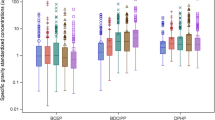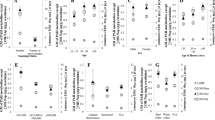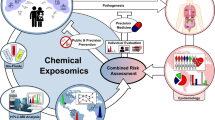Abstract
The use of stable, isotopically labeled compounds in controlled exposure experiments at environmentally relevant levels allows for the distinguishing of urinary metabolites associated with known exposure from background levels generally present in the urine. Exposures of volunteers to 13C-benzene for 2 h at 40±10 p.p.b. were conducted after obtaining informed consent, and urinary phenol, catechol, hydroquinone and trans,trans- muconic acid were measured. Each isotopically labeled urinary metabolite was determined in the presence of significantly higher concentrations of the unlabeled metabolite. Following exposure, free and acid hydrolyzed phenol, acid hydrolyzed catechol and hydroquinone, and free trans,trans-muconic acid were determined by GC/MS. The percentage of trans,trans-muconic acid excreted was higher than reported following exposure at occupational levels. The use of isotopically labeled compounds has the potential to investigate the metabolism of common environmental contaminants for validation of toxicokinetic models and improve risk extrapolation from high concentration occupational exposures and animal studies to environmentally relevant pollutant levels.
This is a preview of subscription content, access via your institution
Access options
Subscribe to this journal
Receive 6 print issues and online access
$259.00 per year
only $43.17 per issue
Buy this article
- Purchase on Springer Link
- Instant access to full article PDF
Prices may be subject to local taxes which are calculated during checkout


Similar content being viewed by others
References
ACGIH. TLVs and BEIs Threshold Limit Values for Chemical Substances and Physical Agents. American Conference of Governmental Industrial Hygienist, Cincinnati, OH, 1998.
Balikova M., and Kohlicek J. Gas chromatography of simple phenols in biological fluids. J Chromatogr 1989: 497: 159–167.
Bechtold W.E., Lucier G., Birnbaum L.S., Yin S.N., Li G.L. and Henderson R.F. Muconic acid determinations in urine as a biological exposure index for workers occupationally exposed to benzene. Am Ind Hygeine Assoc 1991: 52: 473–478.
Bois F.Y., and Paxman, D.G. An analysis of exposure rate effects for benzene using a physiologically based pharmacokinetic model. Regulatory Toxicol Pharmacol 1992: 15: 122–136.
Boogaard P.J., and van Sittert, N.J. Suitability of s-phenyl mercaputric acid and trans,trans-muconic acid as biomarkers for exposure to low concentrations of benzene. Environ Health Perspect 1996: 104 (Suppl 6): 1151–1158.
Brambilla P., Lanbert G.H., Cazzaniga M., Needham L.I., Ferrari E., Patterson Jr. D.G., Gerthoux P., Signorini, S., and Mocarelli P. Caffeine breath test in subjects exposed to dioxin at Seveso: preliminary results. Clin Chem 1995: 41(12): 1926–1927.
Chan C.-C., Lin S.-H., and Her G.-R. Student's exposure to volatile organic compounds while commuting by motorcycle and bus in Taipei City. J Air Waste Manage Assoc 1993: 43: 1231–1238.
Chan C.-C., Spengler J.D., Ozkaynak H., and Befkopoulou M. Commuter exposures to VOCs in Boston, Massachusetts. J Air Water Manage Assoc 1991: 41: 1594–1600.
Ducos P., Gaudin R., Bel J., Maire C., Francin J.M., Robert A., and Wild, P. Trans, trans-muconic acid a reliable biological indicator for the detection of individual benzene exposure down to the ppm level. Occup Environ Health 1992: 64: 309–313.
Eastmond D.A., Smith M.T., and Irons R.D. An interaction of benzene metabolites reproduces the myelotoxicity observed with benzene exposure. Toxicol Appl Pharmacol 1987: 91: 85–95.
Fitzgerald E.F., Brix K.A., Deres D.A., Hwang S.-a., Bush B., Lambert G., and Tarbell A. Polychorinated biphenyl (PCB) and dichlorodiphenyl dichloroethylene (DDE) exposure among Native American men from contaminated Great Lakes fish and wildlife. Toxicol Ind Health 1996: 12(3/4): 361–368.
Gist G.L., and Burg J.R. Benzene — a review of the literature from a health effects perspective. Toxicol Ind Health 1997: 13(6): 661–713.
Gobba F., Rovesti S., Borella P., Vivoli R., Caselgrandi E., and Vivoli G. Inter-individual variability of benzene metabolism to trans, trans muconic acid and its implications in the biological monitoring of occupational exposure. Sci Total Environ 1997: 199: 41–48.
Goldstein B.D., and Witz G. Benzene. In: Lippmann, M. (Eds.). Environmental Toxicants: Human Exposures and Their Health Effects. John Wiley & Sons Inc., New York, 2000, pp. 121–149.
Henderson R.F. Species differences in the metabolism of benzene. Environ Health Perspect 1997: 104 (Suppl 6): 1173–1175.
Henderson R.F., Sabourin P.J., Bechtold W.E., Griffith W.C., Medinsky M.A., Birnbaum L.S., and Lucier G. The effect of dose, dose rate, route of administration and species on tissue and blood levels of benzene metabolites. Environ Health Perspec 1989: 82: 9–17.
Inoue O., Seiji K., Kashara M., Nakatsuka H., Wantabe T., Yin S.-G., Li G.-L., Cai S.-X., Jin C., and Ikeda M. Determination of catechol and quinol in the urine of workers exposed to benzene. Br J Ind Med 1988: 45: 487–492.
Inoue O., Seijl K., Kasahara M., Nakatsuka H., Watanabe T., Yin S.G., Li G.-l., Jin C., Cai S.-X., Wang X.-Z. et al. Quantitative relation of urinary phenol to breathzone benzene concentrations: a factory survey. Br J Ind Med 1986: 43: 692–697.
Inoue O., Seiji K., Nakatsuka H., Watanabe T., Yin S.N., Li G.-L., Cai S.X., J.C, and I.M. Excretion of 1,2,4-benzenetriol in the urine of workers exposed to benzene. Br J Ind Med 1989a: 46: 122–127.
Inoue O., Seijl K., Nakatsuka H., Watanabe T., Yin S.-N., Li G.-L., Cai S.-X., Jin C., and Ikeda M. Urinary t,t muconic acid as an indicator of exposure to benzene. Br J Ind Med 1989b: 46: 122–127.
Kline, S.A., Robertson J.F., Grotz V.L., Goldstein B.D., and Witz G. Identification of 6-hydroxy-trans,trans-2,4-hexadonic acid, a novel ring-opened urinary metabolite of benzene. Environ Health Perspect 1993: 101(4): 310–312.
Lambert G.H., Schoeller D.A., Humphrey H.E.B., Kotake A.N., Lietz H., Campbell M., Kalow W., Spielberg S.P., and Budd M. The caffeine breath test and caffeine urinary metabolite ratios in the Michigan cohort exposed to polybrominated biphenyls: a preliminary study. Environ Health Perspect 1990: 89: 175–181.
Lawryk N. Lioy P.J., and Weisel C.P. Exposure to volatile organic compounds in the passenger compartment of automobiles during periods of normal and malfunctioning operation. J Exposure Anal Environ Epidemiol 1995: 5(4): 511–531.
Lovern M.R., Cole C.E., and Schlosser P.M. A review of quantitative studies of benzene. Crit Rev Toxicol 2001:31(3): 285–311.
Mathews J.M., Etheridge A.S., and Matthews H.B. Dose-dependent metabolism of benzene in hamsters, rats and mice. Toxicol Sci 1998: 44: 14–21.
Medeiros A.M., Bird M.G., and Witz G. Potential biomarkers of benzene exposure. J Toxicol Environ Health 1997: 51: 519–539.
Medinsky M., Sabourin P., Lucier G., Birnbaum L., and Henderson R. A physiological model for simulation of benzene metabolism by rats and mice. Toxicol Appl Pharmacol 1989: 99(2): 193–206.
Medinsky M.A., Kenyon E.M., and Schlosse P.M. Benzene: a case study in parent chemical and metabolite interactions. Toxicology 1995: 105: 225–233.
Morgan M.S., Dills R.L., and Kalman D.A. Evaluation of stable isotope probes in the study of solvent pharmacokinetics in human subjects. Int Arch Occup Environ Health 1993: 65: S139–S142.
Mueller G., Koelbel M., Heger M., and Norpoth K. Urinary S-phenylmercapturic acid and phenylguanine as indicators of benzene exposure. Biological Monitoring of Exposure to Chemicals. Organic Compounds. In: Ho, M. H., and Dillon, H. k. (Eds.). John Wiley and Sons, New York, 1987: pp. 91–98.
Nihlén A., Sumner S.C.J., Lof A., and Johanson, G. 13C 2- Labeled methyl tert-butyl ether: Toxicokinetics and characterization of urinary metabolites in humans. Chem Res Toxicol 1999: 12(8): 822–830.
Ong C.-N., and Lee B.-L. Determination of benzene and its metabolites: Application in biological monitoring of environmental and occupational exposure to benzene. J Chromatogr B 1994: 660: 1–22.
Ong C.N., Lee B.L., Ong H.Y., and Hong L.E. Determination of urinary phenol by acid hydrolysis and capillary gas chromatography. J Anal Toxicol 1988: 12: 159–161.
Ong C.N., Lee B.L., Shi H.Y., and Lee H.P. Elevated levels of benzene-related compounds in the urine of cigarette smokers. Int J Cancer 1994: 59: 177–180.
Parke D.V., and Williams R.T. Studies in detoxification. 49. The metabolism of benzene containing [14C] benzene. Biochem J 1953: 54: 231–238.
Pezzagno G., Maestri L., and Giorentin M.L. Trans, trans muconic acid, a biological indicator to low levels of environmental benzene: some aspects of its specificity. Am J Ind Med 1999: 35: 511–518.
Popp W., Rauscher D., Muller G., Angerer J., and Norpoth K. Concentrations of benzene in blood and S-phenylmercaptureic and t,t-muconic acid in urine in car mechanics. Int Arch Occup Environ Health 1994: 66: 1–6.
Qu Q., Melikian A.A., Li G., Shore R., Chen L., Cohen B., Yin S., Kagan M.R., Li H., Meng M . et al. Validation of biomarkers in humans exposed to benzene: urine metabolites. Am J Ind Med 2000: 37(5): 522–531.
Rabinowitz M.B. Toxicokinetics of bone lead. Environ Health Perspect 1991: 91: 33–37.
Rossi A.M., Guarnieri S., Rovesti S., Gobba F., Ghittori S., Vivoli G., and Varale R. Genetic polymorphisms influence variability in benzene metabolism in humans. Pharmacogenetics 1999: 9(445-451).
Rothman, N., Smitth, M., Hayes, R., Traver, R., Hoener, B., Campleman, S., Li, G., Dosemeci, M., Linet, M., Zhang, L., Xi L., Wacholder S., Lu W., Meyer K.B., Titenkko-Hollandd N., Stewart J.T., Yin S. and Ross D . Benzene poisoning, a risk factor for hematological malignancy, is associated with the NQ01 609C-T mutation and rapid fractional excretion of chlozoxazone. Cancer Res 1997: 57: 2839–2842.
Sabourin P.J., Bechtold L.E., Birnbaum L.S., Lucier G., and Henderson R.F. Differences in the metabolism and disposition of inhaled [3H] benzene by F344/N rats and B6C3F1 mice. Toxicol Appl Pharmacol 1988: 94: 128–140.
Sabourin P.J., Bechtold W.E., Griffith W.C., Birnbaum L.S., Lucier G., and Henderson R.F. Effect of exposure concentration, exposure rate and route of administration on metabolism of benzene by F344 rats and B6C3F mice. Toxicol Appl Pharmacol 1989: 99: 421–444.
Sabourin P.J., Muggenberg B.A., Couch, R.C., Lefler D., Lucier G., Birnbaum L.S., and Henderson, R.F. Metabolism of [14C]benzene by cynomolgus monkeys and chimpanzees. Toxicol Appl Pharmacol 1992: 114: 277–284.
Sabourin P.J., Sun J.D., MacGregor J.T., Wehr C.M., Birnbaum L.S., Lucier G., and Henderson R.F. Effect of repeated benzene inhalation exposures on benzene metabolism, binding to hemoglobin and induction of micronuclei. Toxicol Appl Pharmacol 1990: 103: 452–462.
Scherer G. Renner T., and Mege M. Analysis and evaluation of trans, trans-muconic acid as a biomarker for benzene exposure. J Chromatogr B 1998: 717: 179–199.
Snyder R., and Kalf G. A perspective on benzene leukemogenesis. Crit Rev Toxicol 1994: 24: 177–209.
Snyder R., Witz G., and Goldstein B.D. The toxicology of benzene. Environ Health Perspect 1993: 100: 293–306.
Turnlund J.R. The use of stable isotopes in mineral nutrition research. J Nutr 1989: 119(1): 7–14.
USEPA. Exposure Factors Handbook, Volume I — General Factors, Volume II — Food Ingestion Factors, Volume III — Activity Factors. ORD/NCEA/USEPA, Washington, DC, 1997.
Valentine J.L., Lee S.S.-T., Seaton M.J., Asgharian B., Farris G., Corton J.C., Gonzalez F., and Medinsky M. Reduction of benzene metabolism and toxicity in mice that lack CYP2E1 expression. Toxicol Appl Pharmacol 1996: 141: 205–213.
Van Sittert N.J., Boogaard P.J., and Beulink G.D.J. Application of urinary S-phenylmercapturic acid test as a biomarker for low levels of exposure to benzene in industry. Br J Ind Med 1993: 50: 460–469.
Wallace L. Major sources of exposure to benzene and other volatile organic chemicals. Risk Anal 1990: 10(1): 59–64.
Weisel C.P., Yu R., Roy A., and Georgopoulos P.G. Biomarkers of environmental benzene exposure. Environ Health Perspect 1996: 104 (Suppl 6): 1141–1146.
Witz G., Kirley T.A., Maniara W.M., Mylavarapu W.J., and Goldstein B.D. The metabolism of benzene to muconic acid, a potential biological marker of benzene exposure. Biological Reactive Intermediates IV. In: Witmer, C. M. e. a. (Eds.). Plenum Press, New York, 1990, pp. 613–618.
Witz G., Maniara W., Mylavarapu V., and Goldstein, B.D. Comparative metabolism of benzene and trans,trans-muconaldehyde to trans,trans-muconic acid in DBA/2N and C57BL/6 mice. Bioch Pharmacol 1990: 40(6): 1275–1280.
Witz G. Rao G.S., and Goldstein B.D. Short term toxicity of trans, trans muconaldehyde. Toxicol Appl Pharmacol 1985: 40: 511–516.
Witz G., Zhang Z., and Goldstein B.D. Reactive ring-opened aldehyde metabolites in benzene hematotoxicity. Environ Health Perspect 1996: 104 (Suppl 6): 1195–1199.
Yu R., and Weisel C.P. Measurement of benzene in human breath associated with an environmental exposure. J Exposure Anal Environ Epidemiol 1996a: 6(3): 261–277.
Yu R., and Weisel C.P. Measurement of the urinary benzene metabolite trans,trans-muconic acid from benzene exposure in humans. J Toxicol Environ Health 1996b: 48: 453–457.
Acknowledgements
We acknowledge Mr. Peter Crosby and Dr. Tina Fan for assistance in the controlled exposures and the participants in the study. This work was supported by Grants ES09676 and ES02558 by the National Institute of Environmental Health Sciences. Drs. Weisel and Witz are supported in part by the NIEHS Center Grant ES05022.
Author information
Authors and Affiliations
Corresponding author
Rights and permissions
About this article
Cite this article
Weisel, C., Park, S., Pyo, H. et al. Use of stable isotopically labeled benzene to evaluate environmental exposures. J Expo Sci Environ Epidemiol 13, 393–402 (2003). https://doi.org/10.1038/sj.jea.7500285
Received:
Accepted:
Published:
Issue Date:
DOI: https://doi.org/10.1038/sj.jea.7500285



